When we write content, especially pages, we normally have a focus keyword and a focused goal in mind – “I’m writing this article because I want to get these types of clients/cases.” When we inform our audience about when courts will be opening again to hear their X civil case, are we not only informing but encouraging that audience to potentially contact us with further questions about X? When we are writing about “What do to after a car accident with someone that is uninsured/underinsured,” we are using our compelling content and call-to-actions to not only educate them on their options but also contact the firm for a free consultation so you can eventually guide them through the legal process via legal representation.
Content Length Vs. Consumer Engagement
Hopefully during these content generation sessions, we are being thorough and observing at least some of the best practices for SEO to increase the likelihood of the article being seen. We write our blogs to answer all questions on a subject with 1000-1500 word articles now instead of the 300-500 of the past – though attention spans of consumers have arguably diminished (less than a goldfish yet or what?), there are still plenty of SEO implications for writing great content that may not be completely perused.
Going back to our “focus” though. Great content typically evolves beyond simply the meta title keyword you have to relegate your entire blog into. We may see the traffic come in after hitting on a great content opportunity, see some leads trickle in, and leave it there in satisfaction. But what you may not know is that content that gets you qualified traffic may be visible for literally thousands of keywords that could be used as a huge, viable source of leads indefinitely. And you would not even know you were sitting on it without simply one extremely handy tool: your Google Search Console.
Understanding the Limitless Value of Google Search Console’s Relationship With Your Content Strategy
Google Search Console is often overlooked because of the constant reference to Google Analytics, but I assure you that this tool stands alone as a source of endless data that will take your marketing efforts to the next level. GSC isn’t just for analyzing webmaster messages and if your website is indexing properly – it also offers an entire window into the visibility your website is getting, and most importantly, on the page-level. What we see on Google Analytics is important, of course. We see traffic going to the content we are creating, can narrow it down by organic, see how people engage with it and the site by taking a peek at pages per visit and bounce rate, and if it converted into a lead. GSC will give us impressions, project clicks, and illuminate something big that will be covered the rest of this blog: keywords you had no idea your content was ranking for, and how far off in rankings you are to make a huge difference in the potential traffic you could be getting.
The first place you’ll want to go is “Performance” within GSC. You’ll see some initial stats that will be good at indicating if you’ve been getting steady growth in visibility on your website:
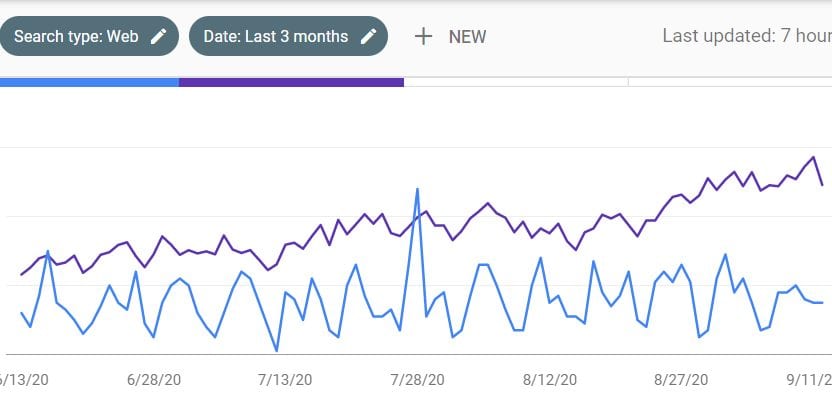 Keep in mind that this isn’t confirmed traffic – impressions are a cumulative projection of how many times your website has been seen from search results, basically as a combination of all the keywords your website ranks for coupled with how they are positioned to be seen, namely being positioned on the first page. The clicks are also more or less projections, based on how many of these keywords are ranked high enough to have a plausible enough click-through percentage.
Keep in mind that this isn’t confirmed traffic – impressions are a cumulative projection of how many times your website has been seen from search results, basically as a combination of all the keywords your website ranks for coupled with how they are positioned to be seen, namely being positioned on the first page. The clicks are also more or less projections, based on how many of these keywords are ranked high enough to have a plausible enough click-through percentage.
You can spend some time browsing through the queries (keywords) and seeing how many keywords you’ve been showing up the most for (it’s pretty entertaining). Some of them you’ll be wondering “how the heck do I get clicks for something so broad like criminal lawyer or injury attorney!” Don’t get too excited – most of the time those occur on the hyper-local level.
After you’re done with queries, we’re going to the standout feature – Pages. From here, you get a breakdown of the pages that are currently getting the most visibility on Google. This will be a great first indicator of what content really is producing and what needs work. This will most likely align fairly similarly to what you see on Google Analytics in the form of traffic, but you’ll be surprised at some of the gaps if you put them side by side. These will already prove to be your first opportunities.
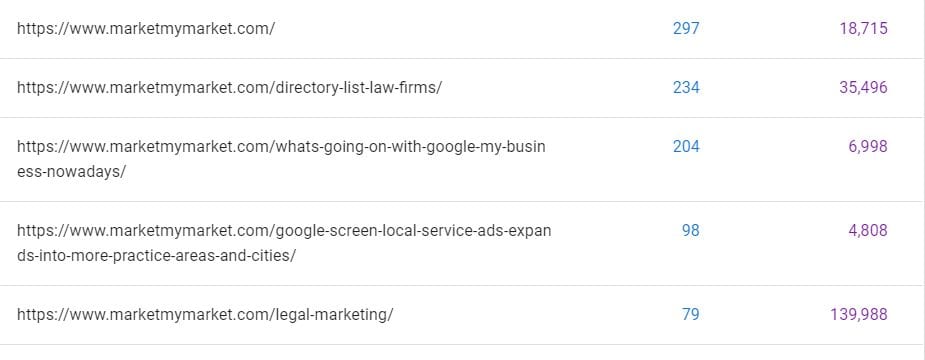 Let’s look at this handful of highest “clicked” pages. You’ll notice that our homepage has a high click-thru (high clicks, lower impressions relative to the other results). This will happen for most websites because the homepage includes your branded keywords. So anyone searching “market my market” will land here. This is the most crucial part of the blog from here on in – when doing the same steps, click on the link and you should be taken to a page that looks like this:
Let’s look at this handful of highest “clicked” pages. You’ll notice that our homepage has a high click-thru (high clicks, lower impressions relative to the other results). This will happen for most websites because the homepage includes your branded keywords. So anyone searching “market my market” will land here. This is the most crucial part of the blog from here on in – when doing the same steps, click on the link and you should be taken to a page that looks like this:
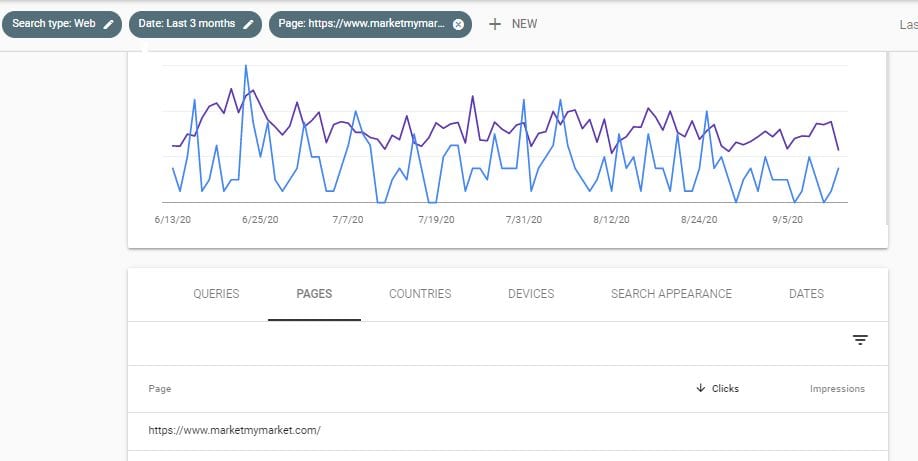 Notice how now we have filtered pages only by this one – you can see the filter that includes the exact page above.
Notice how now we have filtered pages only by this one – you can see the filter that includes the exact page above.
From here, now click on Queries and voila, you can now see all the keywords getting impressions and clicks on this page (told you it was heavily branded). Do this through all of your top pages, especially the ones with massive impressions, and you’ll start to see the potential all the content on your website currently has.
From a brief analysis, when our content has high clicks and low impressions, then the keywords we’re ranking for are either branded or are currently ranked very high, around the top 3. When they are lower clicks and high impressions, we are ranking for multiple high-volume keywords, but have a bit longer to go by being lower on the first page and sometimes higher on the second page.
This is when you want to introduce clicking on the “average position” button to see how far you are from a desirable position. You may also want to reduce the Date filter to be more recent to have a more accurate average position – possibly 28 days, probably 7 days. Just keep in mind with this filter you will begin to exclude potential keywords that you could show up for because of a smaller time frame.
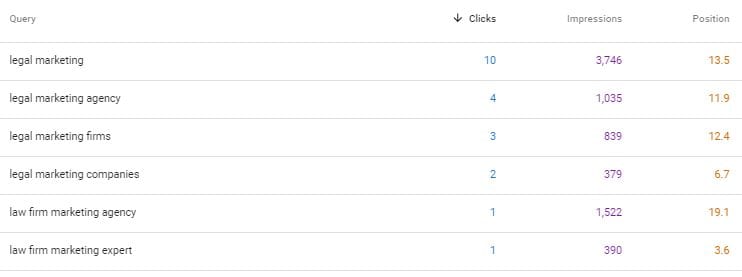 We can make a few judgments here:
We can make a few judgments here:
- We are currently optimized more heavily for “legal marketing companies” which is resulting in us often times being top 5 in the county, but it is less volume than “legal marketing agency.”
- Should we scratch both and just become an authority for “legal marketing”? But would far fewer people have intent to actually work with a professional, and instead educate themselves to do it more on their own?
- “Law firm marketing expert” looks like a good opportunity and it is not beyond reach. Maybe we should add some content to solidify 1 there.
This is only one page – legal websites with comprehensive marketing plans have hundreds if not thousands of pages. You could make decisions such as these almost until the end of time. That’s why it’s important to work your way down pages that have what you perceive to be the most intent.
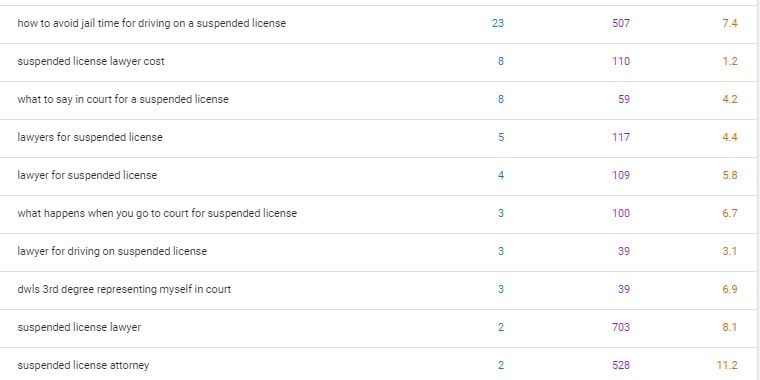
See above – this is a blog being analyzed on GSC that answers the question “Should I get a Lawyer for a Driving While License Suspended Charge?”
The number 1 exact phrase that gets traffic here is “how to avoid jail time for driving on a suspended license,” which answers a question but may not have intent. But if you look just a little below, you already see great qualified keywords like “lawyers for suspended license,” “lawyer for suspended license,” “suspended license lawyer,” and “suspended license attorney.” These are excellent keywords that get leads (again I would typically regard the “clicks” column. These are estimates based off of click-thru and we don’t give too much notice to these without consulting Google Analytics.)
So what does this all mean? To start, this blog is likely getting more traffic than the dedicated “Suspended License Attorney” page that exists under practice areas on the page. That gives us the decision to maybe look into re-optimizing that page to include more geographic information and keep letting this blog do its thing.
What Does it All Mean?
This Suspended License blog ranks for 474 keywords in the last 28 days according to GSC. If we order it by impressions, we see that “suspended license lawyer” has 703 impressions and averages 8.1 on the first page. We should be thinking about boosting that up and leveraging the success the blog has already had, and we can do that by:
- Confirming the keyword is used appropriately on the page, and is possibly in H1/H2 tags
- Adding content to the page to answer another question or two, especially if the page is having this much success with a lower word count ( < 800 words)
- Consider building a few links directly to the page to give it some more page-level authority
- Seeing if there are internal linking opportunities to link right to this page
- Add other assets to the page if they are available, such as videos and images
Sometimes a great content plan isn’t just continuing to produce more and more content – it could be taking a step back and evaluating the success you’ve had with your current content and seeing how you can improve upon it. Most of the time, we’re doing both simultaneously.
Take the Next Step
Part of a successful partnership with a digital marketing agency is working with a team of SEO experts who understand how to acquire and interpret the data that should influence your content strategy. Find out how we can help your content succeed with a consultation. Contact us to learn more!

MMM Author Ryan Klein
The ongoing digital revolution is transforming the way that all businesses interact with clients and customers. Consumers rely heavily on digital channels for researching products and services and expect to make buying choices with the swipe of a finger. For organizations that want to remain competitive, having a defined digital marketing strategy and execution plan is essential for successful outcomes. With a demonstrated history of creating and implementing strategic digital marketing initiatives that drive growth, I am committed to delivering real, measurable results for my clients.
